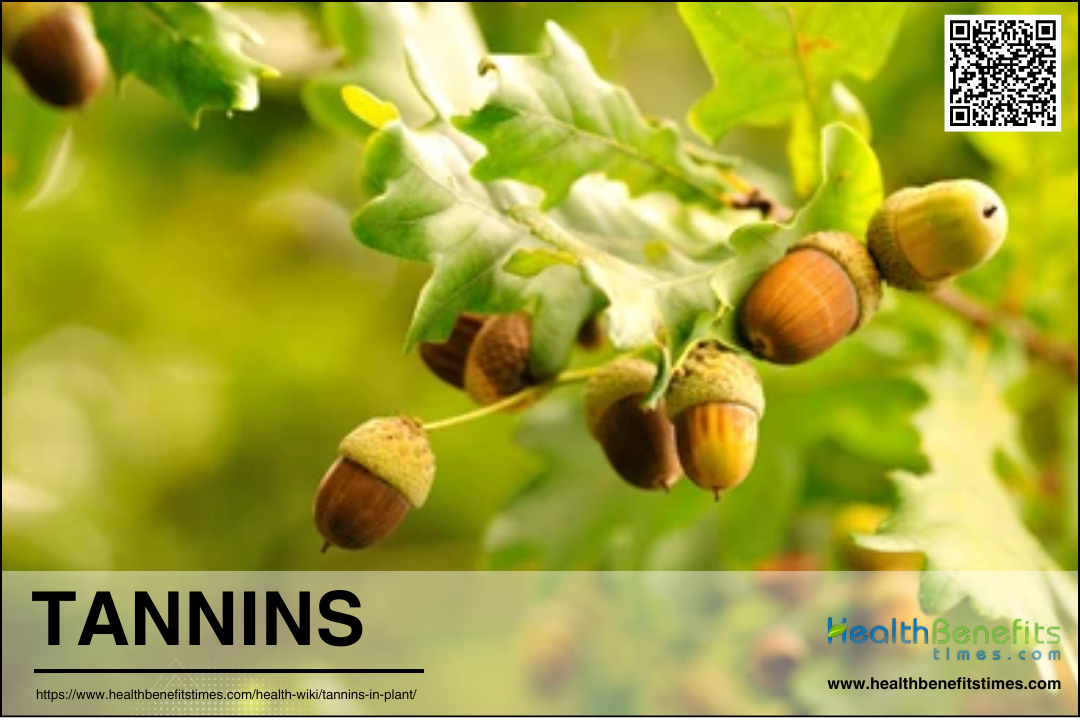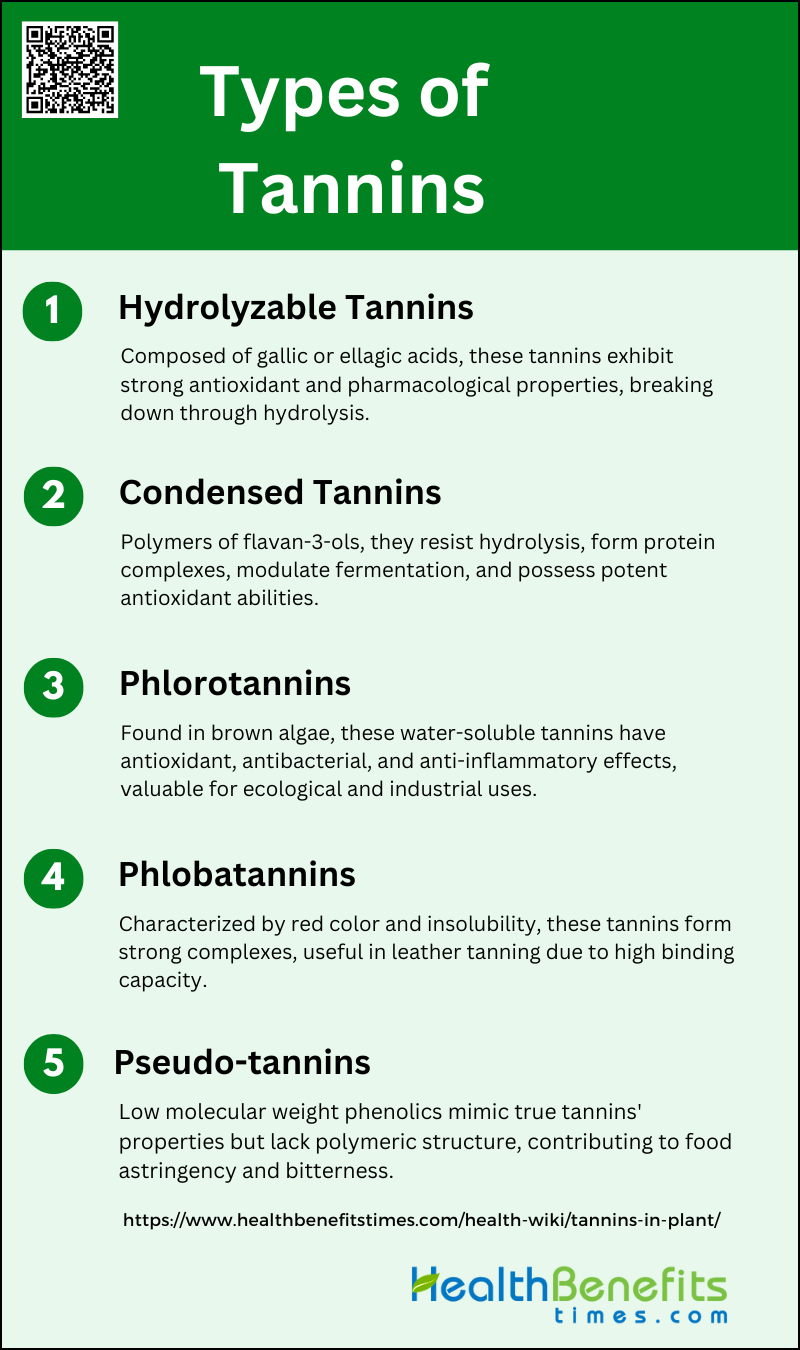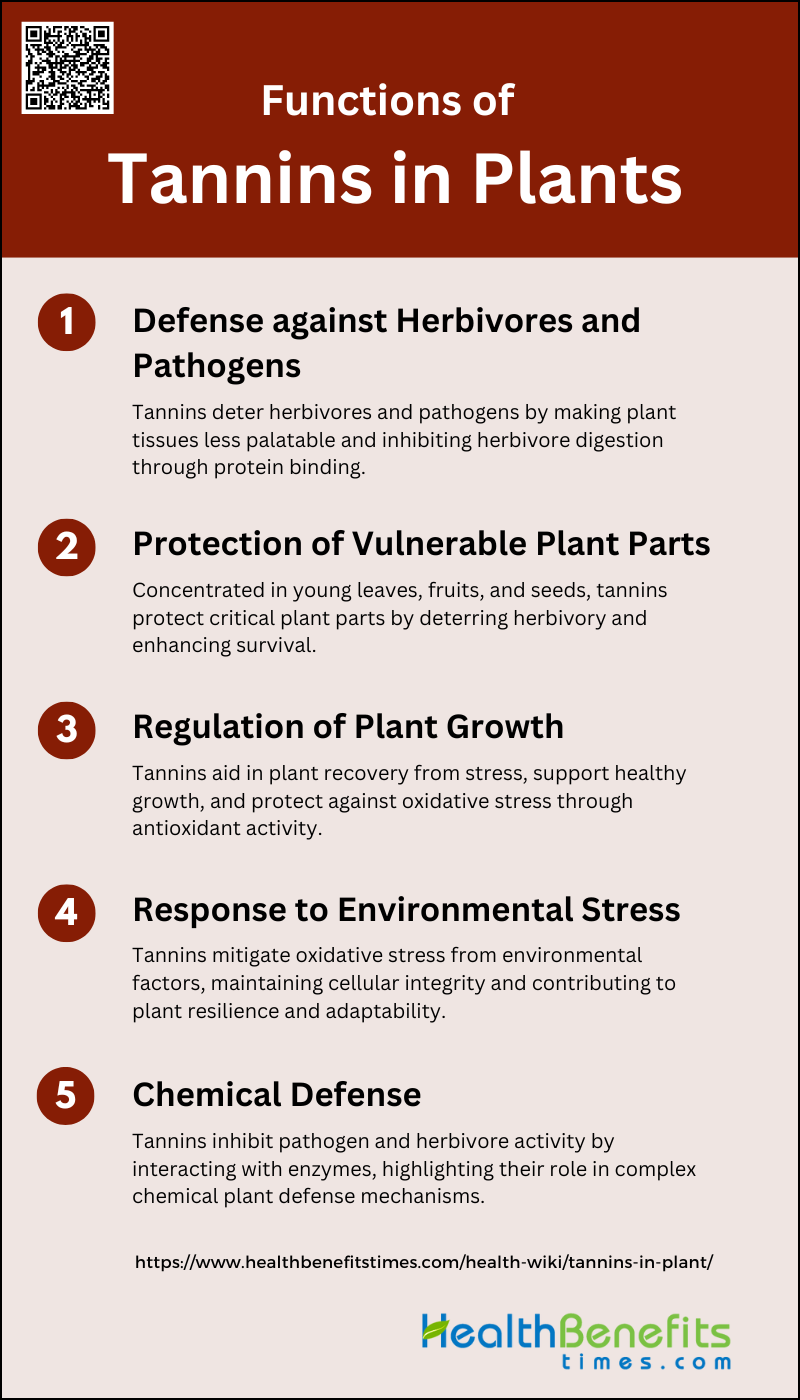Tannins are a diverse group of polyphenolic compounds found abundantly in plants, serving as secondary metabolites with significant ecological and physiological roles. They are primarily classified into two categories: hydrolysable tannins, which are esters of gallic or ellagic acid, and condensed tannins, also known as proanthocyanidins, composed of flavan-3-ol subunits. These compounds are known for their ability to bind and precipitate proteins, which can have both beneficial and adverse effects depending on their concentration and chemical structure. In the context of animal husbandry, tannins have been studied for their potential to improve nutrient utilization and reduce methane emissions in ruminants, thus contributing to environmental sustainability. Additionally, tannins exhibit various biological activities, including antioxidative, antitumor, and antidiabetic properties, making them valuable in both agricultural and medicinal applications.
Types of Tannins
Tannins are categorized based on their chemical structure and properties. Understanding the different types of tannins is crucial for their application in industries ranging from agriculture to medicine. Here are the main types of tannins:
1. Hydrolyzable Tannins
Hydrolyzable tannins are a class of tannins that can be broken down into simpler molecules through hydrolysis. They are primarily composed of gallic acid or ellagic acid esters linked to a core polyol, usually glucose. Examples include gallotannins and ellagitannins. These tannins are known for their strong antioxidant properties, which contribute to their biological activities such as superoxide anion scavenging, apoptosis induction, and antitumor effects. They also exhibit significant pharmacological actions, including anti-EVB, anti-MRSA, and anti-plasmin inhibitory activities.
2. Condensed Tannins
Condensed tannins, also known as proanthocyanidins, are polymers of flavan-3-ols such as catechin and epicat echin. Unlike hydrolyzable tannins, they do not break down easily through hydrolysis. These tannins are found in a variety of plants, including forage trees, shrubs, and legumes. They are known for their ability to form complexes with proteins, which can modulate rumen fermentation in ruminants, reduce protein degradation, and inhibit methanogenesis. Condensed tannins also exhibit strong antioxidant properties, making them effective at quenching peroxyl radicals and reacting with hydroxyl radicals.
3. Phlorotannins
Phlorotannins are a unique type of tannin found exclusively in brown algae. They are polymers of phloroglucinol and are known for their high solubility in water. These tannins have been identified in various species of brown algae, such as Sargassum wightii and Colpomenia sinuosa. Phlorotannins exhibit a range of biological activities, including antioxidant, antibacterial, and anti-inflammatory effects. They are also effective in protecting against insect infestation, making them valuable for both ecological and industrial applications.
4. Phlobatannins
Phlobatannins are a less common type of tannin characterized by their red coloration and insolubility in water. They are polymers of flavan-3-ols and are typically found in the bark and heartwood of certain trees. Phlobatannins are known for their ability to form strong complexes with proteins and other macromolecules, which can contribute to their astringent properties. These tannins have been studied for their potential use in leather tanning and other industrial applications due to their high binding capacity.
5. Pseudo-tannins
Pseudo-tannins are compounds that exhibit some of the properties of true tannins but do not meet all the criteria to be classified as such. They are usually low molecular weight phenolics that can form complexes with proteins but lack the polymeric structure of true tannins. Examples include simple phenolics like catechins and gallic acid. Pseudo-tannins are often found in various fruits and vegetables and are known for their antioxidant properties. They can also contribute to the astringency and bitterness of certain foods and beverages.
Sources of Tannins in Plants
Common Plants Containing High Levels of Tannins
Tannins are abundant in various plants, contributing to their defense mechanisms and ecological interactions. Some common plants known for high tannin content include oak (Quercus species), chestnut (Castanea species), and tea (Camellia sinensis). Additionally, fruits such as grapes (Vitis vinifera) and berries, including aronia and cranberries, are rich in tannins. These compounds are also prevalent in certain herbs and shrubs, such as those from the Lamiaceae family, which includes mint and rosemary. The presence of tannins in these plants not only aids in their survival by deterring herbivores but also provides potential health benefits when used in medicinal and dietary applications.
How Plants Produce Tannins
Plants produce tannins through complex biosynthetic pathways involving the shikimate and phenylpropanoid pathways. These pathways lead to the formation of phenolic compounds, which are precursors to tannins. In response to environmental stressors, such as herbivory or pathogen attack, plants can upregulate the expression of genes involved in tannin biosynthesis. For instance, the production of tannins in Quercus species can be influenced by biotic stress, such as defoliation or infection, which triggers the expression of specific enzymes like shikimate dehydrogenase and anthocyanidin reductase. This dynamic production process allows plants to effectively use tannins as chemical defenses against various threats.
Functions of Tannins in Plants
Tannins serve multiple essential functions in plants, primarily as a defense mechanism against herbivores and pathogens due to their astringent properties. They also play a role in plant growth regulation and structural integrity by interacting with proteins and enzymes. Below are the key functions of tannins in plants:
1. Defense against Herbivores and Pathogens
Tannins play a crucial role in plant defense mechanisms against herbivores and pathogens. These phenolic compounds are known for their ability to deter herbivores by making plant tissues less palatable and nutritious. Tannins achieve this by binding to proteins and other macromolecules, which can inhibit digestive enzymes in herbivores, thereby reducing their ability to extract nutrients from the plant. Additionally, tannins can produce reactive oxygen species that are toxic to herbivores, particularly insects with high pH guts. This dual mechanism of deterrence and toxicity makes tannins effective in protecting plants from a wide range of herbivores and pathogens.
2. Protection of Vulnerable Plant Parts
Tannins are often concentrated in the most vulnerable parts of plants, such as young leaves, fruits, and seeds, to provide protection against herbivores and pathogens. These compounds can be found in higher concentrations in woody, lignified tissues and may vary with the age of the plant part. For instance, in Quercus ilex, tannin biosynthesis is upregulated in response to mechanical defoliation, indicating a protective role against herbivory. This strategic allocation of tannins ensures that the most critical parts of the plant are well-defended, thereby enhancing the plant’s overall survival and reproductive success.
3. Regulation of Plant Growth
Tannins also play a role in regulating plant growth. They are involved in the plant’s response to various biotic and abiotic stresses, which can influence growth patterns. For example, in hybrid poplar, condensed tannins have been shown to increase nitrogen recovery following insect defoliation, thereby aiding in the plant’s recovery and growth after stress events. Additionally, tannins can act as antioxidants, protecting plants from oxidative stress and thereby supporting healthy growth. This regulatory function highlights the multifaceted roles of tannins in plant physiology beyond mere defense.
4. Response to Environmental Stress
Tannins are integral to the plant’s response to environmental stress, including oxidative stress caused by high light intensity and nutrient deficiencies. In hybrid poplar, stress-induced production of condensed tannins is closely matched by an increase in antioxidant activity, which helps protect the plant from oxidative damage. This antioxidant property of tannins is crucial for maintaining cellular integrity and function under stressful conditions. By mitigating the effects of environmental stress, tannins contribute to the plant’s resilience and adaptability.
5. Chemical Defense
Tannins serve as a chemical defense mechanism by interacting with various organic nitrogen compounds and enzymes, thereby inhibiting the activity of pathogens and herbivores. These interactions can either increase or decrease enzyme activity, depending on the specific context, thus providing a versatile defense strategy. Additionally, tannins can degrade through the action of tannase, an enzyme produced by some phytopathogens, which highlights the ongoing evolutionary arms race between plants and their enemies. This complex chemical defense system underscores the importance of tannins in plant survival and ecological interactions.
Benefits of Tannins for Humans
Tannins offer numerous health benefits for humans. These compounds are known for their antioxidant properties and their ability to enhance glucose uptake in muscle cells. Below are some key benefits of tannins for human health:
1. Antioxidant Properties
Tannins, a group of natural polyphenols, exhibit significant antioxidant properties that contribute to human health. These compounds, found abundantly in various fruits, vegetables, and cereals, act as free radical scavengers, chelate transition metals, and inhibit prooxidative enzymes and lipid peroxidation. Studies have shown that dietary supplementation of tannins can improve the oxidative status of blood plasma and enhance the antioxidant capacity of dairy products. The antioxidant activity of tannins is crucial in protecting cellular structures from oxidative damage, thereby preventing oxidative stress-related diseases.
2. Antimicrobial and Antiviral Effects
Tannins possess potent antimicrobial and antiviral properties, making them effective against a wide range of pathogens. They inhibit the growth of fungi, yeasts, bacteria, and viruses through various mechanisms, including iron chelation, disruption of cell membranes, and inhibition of cell wall synthesis. Tannins can also act as quorum sensing inhibitors, reducing the expression of virulence factors in bacteria. These properties make tannins a promising alternative to antibiotics, especially in the context of rising antibiotic resistance. Additionally, tannins’ antimicrobial effects can be harnessed in food processing to extend shelf life and prevent spoilage.
3. Blood Sugar Regulation
Tannins have shown potential in regulating blood sugar levels, which is beneficial for managing metabolic disorders such as diabetes. They exhibit antidiabetic properties by inhibiting enzymes involved in carbohydrate digestion and absorption, thereby reducing postprandial blood glucose levels. The gut microbiota also plays a role in the metabolism of tannins, producing bioaccessible metabolites that contribute to their antidiabetic effects. These findings suggest that tannins can be an effective dietary component for preventing and managing diabetes and other metabolic disorders.
4. Cardiovascular Health
Tannins contribute to cardiovascular health through their antioxidant, anti-inflammatory, and anti-thrombotic properties. They help prevent oxidative stress-related cardiovascular diseases by scavenging free radicals and inhibiting lipid peroxidation. Ellagitannins, a type of hydrolysable tannin, have been shown to exhibit anti-atherogenic and anti-angiogenic effects, supporting vascular health. Although in vitro studies provide strong evidence for these benefits, further research is needed to confirm these effects in vivo due to the low bioavailability of tannins. Nonetheless, tannins remain a promising component for cardiovascular disease prevention.
5. Anti-inflammatory Effects
Tannins exhibit significant anti-inflammatory properties, which are beneficial in managing chronic inflammatory conditions. They modulate the immune response by influencing cytokine profiles, reducing pro-inflammatory cytokines, and increasing anti-inflammatory cytokines. Tannins also inhibit the activity of enzymes involved in the inflammatory process, further contributing to their anti-inflammatory effects. These properties make tannins a valuable dietary component for reducing inflammation and preventing related diseases.
6. Promote Blood Clotting
Tannins have been reported to accelerate blood clotting, which can be beneficial in certain medical conditions. This hemostatic effect is attributed to their ability to precipitate proteins and form complexes with metal ions, which are essential for the clotting process. The pro-coagulant properties of tannins can be useful in managing bleeding disorders and during surgical procedures to reduce blood loss. However, the dosage and type of tannins are critical factors that influence their effectiveness and safety in promoting blood clotting. Further research is needed to fully understand the mechanisms and potential therapeutic applications of tannins in hemostasis.
Tannins in Food and Beverages
Impact on Taste
Astringency, a dry and puckering mouthfeel, is a significant sensory attribute in tea, wine, and certain fruits, primarily caused by tannins. In tea and wine, tannins interact with salivary proteins, reducing saliva’s lubricating properties and increasing friction, which contributes to the tactile sensation of astringency. The composition of tannins, including polymer size and galloylation, influences the degree of astringency and bitterness perceived. Additionally, factors such as pH, ethanol levels, and the presence of other compounds like anthocyanins and polysaccharides in wine can modulate these sensations. Individual differences in salivary flow rates and protein composition also affect the perception of astringency, leading to varied preferences and acceptance among consumers.
How Tannin Content Affects Food Preparation and Consumption
Tannin content significantly impacts food preparation and consumption by influencing the sensory properties and overall palatability of foods and beverages. High tannin levels can lead to excessive astringency, which is often undesirable in fruits and their products, necessitating methods for astringency regulation and removal to improve fruit quality. In culinary practices, the interaction of tannins with proteins can affect the texture and mouthfeel of dishes, as seen in the increased astringency of red wine when consumed with dark chocolate compared to milk chocolate. Moreover, the presence of tannins in foods can interfere with mastication and swallowing by altering saliva’s lubricating properties, potentially leading to increased tooth wear if not managed properly. Understanding these effects is crucial for optimizing food preparation techniques and enhancing consumer enjoyment.
Environmental Impact of Tannins
Role in Soil Health and Nutrient Cycling
Tannins play a significant role in soil health and nutrient cycling, particularly in alpine and forest ecosystems. They can affect nutrient dynamics by hindering decomposition rates, complexing proteins, and inducing toxicity to microbial populations, which in turn inhibits enzyme activities essential for nutrient cycling. This can lead to reduced nutrient losses in infertile ecosystems and alter nitrogen cycling to favor organic over mineral forms of nitrogen. In alpine soils, tannins from plant litter do not exhibit toxic effects on microbial populations but can influence carbon and nitrogen mineralization rates, especially under varying temperature conditions. This suggests that tannins and soil temperatures are crucial controls of microbial catabolism, impacting ecosystem functioning and carbon storage.
Influence on Water Bodies and Aquatic Life
Tannins have a notable impact on aquatic ecosystems, particularly through their interactions with dissolved organic nitrogen (DON) and microbial communities. In mangrove ecosystems, tannins can precipitate in saline water and bind to sediments, influencing DON cycling by preventing rapid export or microbial mineralization of nitrogen. However, tannins can also exhibit ecotoxicity towards specific non-target aquatic organisms, such as Vibrio fischeri and Daphnia magna, affecting their growth and metabolic activities. Additionally, tannins can inhibit microbial growth, respiration, and metabolism in aquatic environments, although some microorganisms are capable of degrading tannins under certain conditions. These interactions highlight the complex role of tannins in aquatic ecosystems, affecting both nutrient cycling and the health of aquatic life.
Potential Side Effects of Tannins
Tannins, while beneficial in many ways, can also have potential side effects when consumed in large quantities. These compounds may interfere with nutrient absorption and cause digestive issues. Below are some potential side effects of tannins:
1. Digestive Issues
Tannins are known to cause digestive issues by forming complexes with macromolecules such as proteins, structural carbohydrates, and starch, which can decrease their digestibility. This binding ability of tannins can lead to reduced feed intake and growth rates in animals, as well as lower feed efficiency and net metabolizable energy. In ruminants, tannins can negatively affect rumen fermentation and nutrient absorption, leading to decreased production performance. Additionally, tannins can inactivate digestive enzymes, further impairing the digestive process and leading to gastrointestinal discomfort and other digestive issues.
2. Reduced Iron Absorption
Tannins significantly impact iron bioavailability by forming insoluble complexes with iron, thereby reducing its absorption in the gut. This effect is particularly evident in single-meal studies where hydrolyzable and oligomeric tannins, such as those found in tea and tannic acid, have been shown to decrease iron bioavailability. However, long-term studies suggest that the body may adapt to tannin consumption, potentially mitigating some of these effects over time. Despite this, the overall consensus is that tannin-rich diets can contribute to iron deficiency, a global health issue, by reducing the bioavailability of dietary iron.
3. Antinutritional Effects
Tannins are considered antinutritional factors because they can decrease the nutritional value of foods by binding to proteins and other macromolecules, making them less digestible. This binding can lead to the formation of tannin-protein complexes, which inactivate digestive enzymes and reduce protein solubility, thereby impairing nutrient absorption. Additionally, tannins can lower feed efficiency and growth rates in animals, further highlighting their antinutritional properties. Despite these negative effects, some studies suggest that proper processing methods, such as dehulling and cooking, can reduce the antinutritional activity of tannins.
4. Potential Carcinogenic Effects
The potential carcinogenic effects of tannins are a subject of ongoing debate. Some studies have linked the consumption of tannin-rich foods, such as betel nuts and certain herbal teas, to an increased risk of cancers like esophageal cancer. However, other reports suggest that the carcinogenic activity may be related to components associated with tannins rather than the tannins themselves. Interestingly, many tannin components, particularly those found in tea, have been shown to have anticarcinogenic properties, possibly due to their antioxidative capabilities, which protect against cellular oxidative damage.
5. Hepatotoxicity
Tannins have been reported to exert hepatotoxic effects, which can lead to liver damage. The hepatotoxic activity of tannins is associated with their ability to produce liver necrosis and other forms of liver injury. The extent of hepatotoxicity can vary depending on the type and dosage of tannins consumed. While some tannins may have beneficial health effects at low doses, higher doses can be detrimental to liver health. Therefore, understanding the safe limits of tannin consumption is crucial to avoid potential hepatotoxic effects.
6. Constipation
Tannins can contribute to constipation due to their astringent properties, which can lead to the binding of proteins and other macromolecules in the gut, reducing their digestibility and slowing down intestinal transit. This binding effect can result in harder stools and difficulty in bowel movements. Additionally, the reduced digestibility of nutrients caused by tannins can further exacerbate constipation. While tannins have various health benefits, their potential to cause constipation highlights the need for balanced consumption and consideration of their effects on digestive health.






